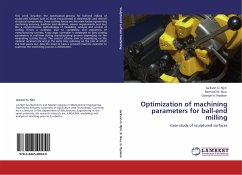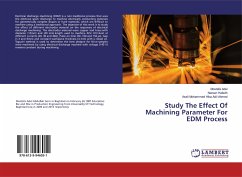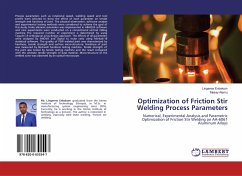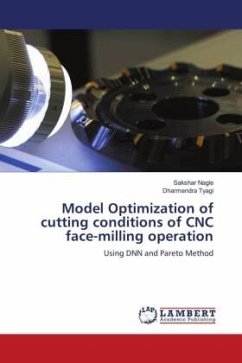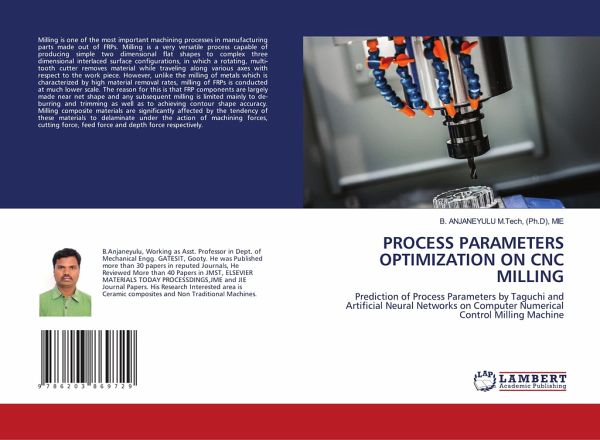
PROCESS PARAMETERS OPTIMIZATION ON CNC MILLING
Prediction of Process Parameters by Taguchi and Artificial Neural Networks on Computer Numerical Control Milling Machine
Versandfertig in 1-2 Wochen
26,99 €
inkl. MwSt.

PAYBACK Punkte
13 °P sammeln!
Milling is one of the most important machining processes in manufacturing parts made out of FRPs. Milling is a very versatile process capable of producing simple two dimensional flat shapes to complex three dimensional interlaced surface configurations, in which a rotating, multi-tooth cutter removes material while traveling along various axes with respect to the work piece. However, unlike the milling of metals which is characterized by high material removal rates, milling of FRPs is conducted at much lower scale. The reason for this is that FRP components are largely made near net shape and ...
Milling is one of the most important machining processes in manufacturing parts made out of FRPs. Milling is a very versatile process capable of producing simple two dimensional flat shapes to complex three dimensional interlaced surface configurations, in which a rotating, multi-tooth cutter removes material while traveling along various axes with respect to the work piece. However, unlike the milling of metals which is characterized by high material removal rates, milling of FRPs is conducted at much lower scale. The reason for this is that FRP components are largely made near net shape and any subsequent milling is limited mainly to de-burring and trimming as well as to achieving contour shape accuracy. Milling composite materials are significantly affected by the tendency of these materials to delaminate under the action of machining forces, cutting force, feed force and depth force respectively.
Milling is one of the most important machining processes in manufacturing parts made out of FRPs. Milling is a very versatile process capable of producing simple two dimensional flat shapes to complex three dimensional interlaced surface configurations, in which a rotating, multi-tooth cutter removes material while traveling along various axes with respect to the work piece. However, unlike the milling of metals which is characterized by high material removal rates, milling of FRPs is conducted at much lower scale. The reason for this is that FRP components are largely made near net shape and any subsequent milling is limited mainly to de-burring and trimming as well as to achieving contour shape accuracy. Milling composite materials are significantly affected by the tendency of these materials to delaminate under the action of machining forces, cutting force, feed force and depth force respectively.
Milling is one of the most important machining processes in manufacturing parts made out of FRPs. Milling is a very versatile process capable of producing simple two dimensional flat shapes to complex three dimensional interlaced surface configurations, in which a rotating, multi-tooth cutter removes material while traveling along various axes with respect to the work piece. However, unlike the milling of metals which is characterized by high material removal rates, milling of FRPs is conducted at much lower scale. The reason for this is that FRP components are largely made near net shape and any subsequent milling is limited mainly to de-burring and trimming as well as to achieving contour shape accuracy. Milling composite materials are significantly affected by the tendency of these materials to delaminate under the action of machining forces, cutting force, feed force and depth force respectively.








